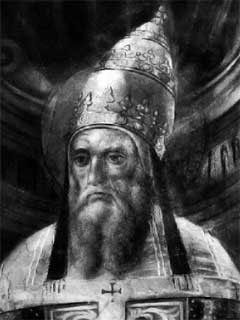 Saint Callistus began his life as a slave and ended it as pope, murdered or martyred around the year 222 AD.
Saint Callistus began his life as a slave and ended it as pope, murdered or martyred around the year 222 AD.
Callistus’ biography was written by one of his ecclesial enemies, Hippolytus, so it presents a somewhat biased and unfavorable view of Callistus. Hippolytus was the clear favorite for papal election but he was passed over in favor of Callistus, causing Hippolytus no small amount of envy. Hippolytus vehemently disagreed with Callistus’ policy of reversing the excommunications of those who had committed murder and adultery and bringing them back into the Church, upon their repentance. Despite his uncharitable bias, there are some certain definite facts that can be gleaned from Hippolytus' account, known as the Philosophumena.
Callistus was a slave, born in late second-century Rome. Callistus' Christian master put him in charge of a bank that held money for the local community. Callistus irresponsibly lost the money, either through dishonest investment or careless stewardship, and fled the wrath of his master.
When pursuers closed in, he jumped into the sea, but was caught and sentenced to work in a mill. The people who had lost money from his bad investments wanted Callistus returned so that he could recover their funds. Facing mounting pressure to return the lost money, Callistus tried to collect from other debtors, who promptly initiated a brawl. After this misdemeanor, Callistus was sentenced to work in the mines with other Christian prisoners.
Mercifully, Emperor Commodus granted amnesty to many imprisoned Christians in the mines, and Callistus was released. He made his way back to Rome and re-established himself in the community. Pope Victor I gave him a pension, and Callistus' health, taxed from years of hard labor, began to recover.
When St. Zephyrinus was elected pope in 199, he put Callistus in charge of a public cemetery for Christians. This was one of the first pieces of property in Rome that the Church owned, and unlike his earlier experience with stewarding money, Callistus managed the cemetery wisely. This cemetery eventually became known as the Catacombs of Saint Callistus on the Via Appia Antica. There are at least nine popes now buried there. After Callistus' excellent stewardship of this cemetery, Zephyrinus asked Callistus to serve as one of his counselors, and he ordained him a deacon. The two became close friends.
 When Zephyrinus died, Callistus was elected pope in 217 by a majority of the Christians in Rome, according to the custom of the time. He was merciful in dealing with sinners, reversing excommunications and working to preserve orthodox Christianity against various schisms and heresies. He has also been credited with the official implementation of the Ember Day fasts.
When Zephyrinus died, Callistus was elected pope in 217 by a majority of the Christians in Rome, according to the custom of the time. He was merciful in dealing with sinners, reversing excommunications and working to preserve orthodox Christianity against various schisms and heresies. He has also been credited with the official implementation of the Ember Day fasts.
It is possible that Callistus was martyred—not in an imperial persecution, but perhaps in some kind of popular uprising—or he was murdered. Legend has that he was thrown into a well, perhaps because of this legend his titular church contains a well. Some of Callistus' relics rest in the reliquary chapel at the Basilica of the Sacred Heart on Notre Dame's campus, and his image is used here above with permission from Catholic.org.
St. Callistus, the young slave who became pope—pray for us!